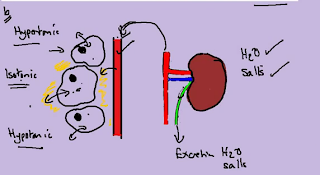EXCRETION
Kidneys excrete urea
-Urea contain nitrogen
-Nitrogen is toxic to the body and cannot be stored
-Amino acids contain nitrogen
-Amino acids are used for growth but excess amino acids must be removed because they are toxic.
-Removing the excess amino acids is the job of the liver and the kidneys
1) Blood circulates to the liver and the amino acids are broken down and are converted to urea
2) This reenters the blood stream and to be removed from the body it circulates to the kidneys
3) The kidneys filter the urea from the blood and water will be added to the urea and forms urine.
4) Urine drains down the uriters to collect in the bladder.
Urea is now in the bladder in the form of urine. (Removed from the body)
OSMOREGULATION
Osmo = Osmosis
Regulation = Control
-The tissue fluid which surround the cells must be isotonic with the cytoplasm of these cells (Amount of water in&out is =. The cells will remain the same size/shape and maintain their function)
-The danger to the tissue is that blood circulating into the tissue would be concentrated causing a hypertonic tissue fluid or it may be very dilute causing a hypotonic tissue fluid (Both of these are undesirable)
We want to keep the tissue fluid isotonic to the cell cytoplasm.
This is achieved by controlling the composition of blood. blood forms the tissue fluid.
It is the role of the kidney to control the composition of our blood.
Blood which circulates through our kidney
Excess water and salts can be removed and excreted through the ureter to control the composition of the blood and this means that the tissue fluid could be kept isotonic with the cells cytoplasm.


No comments:
Post a Comment